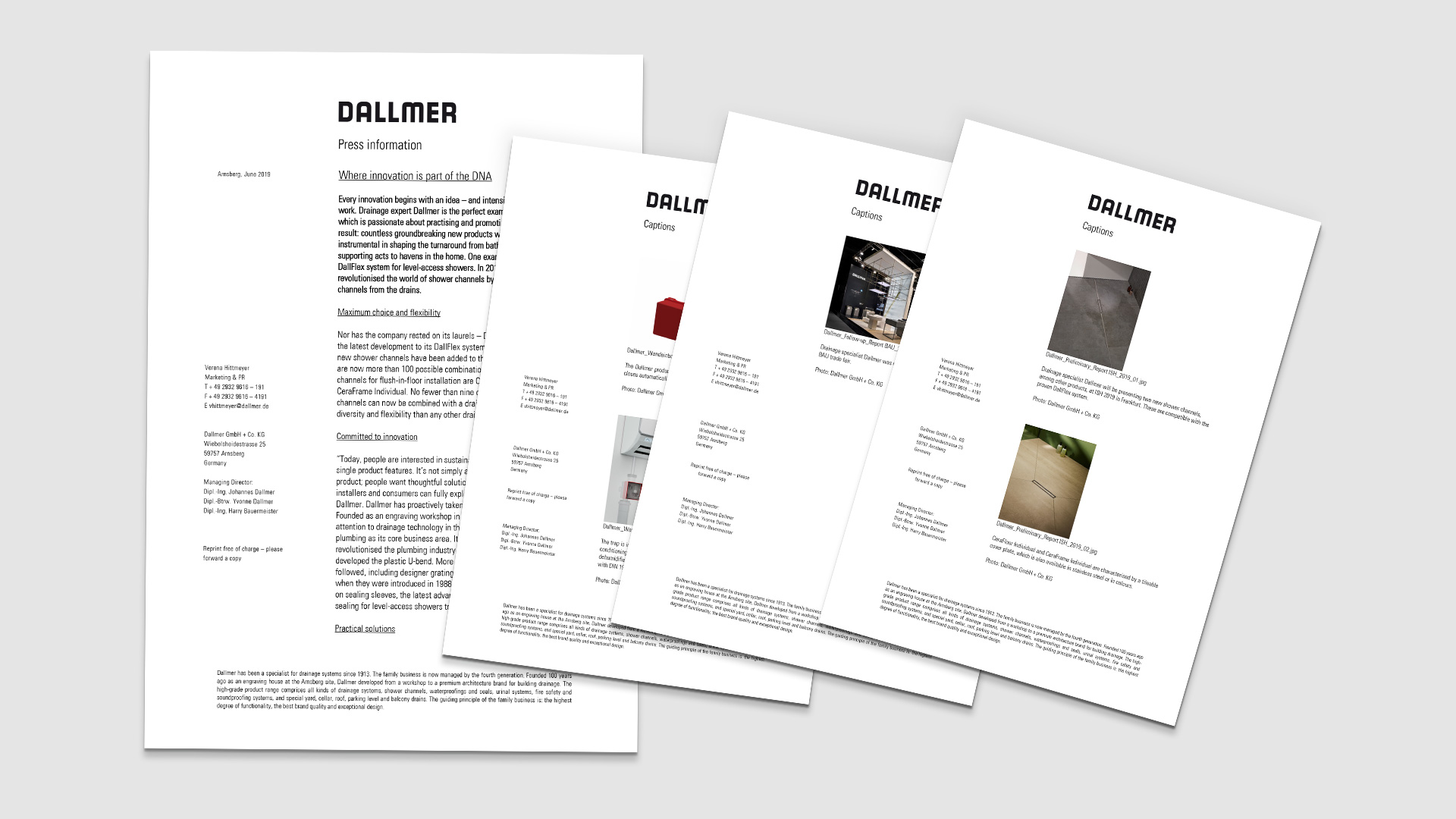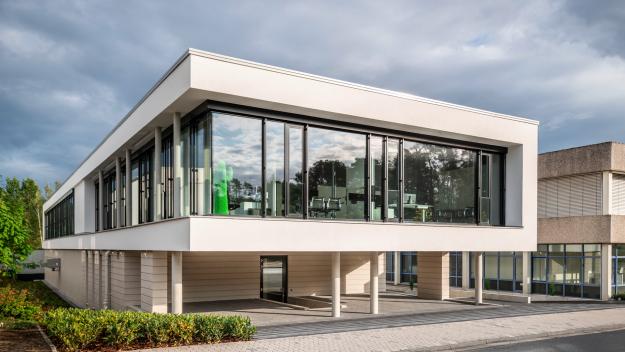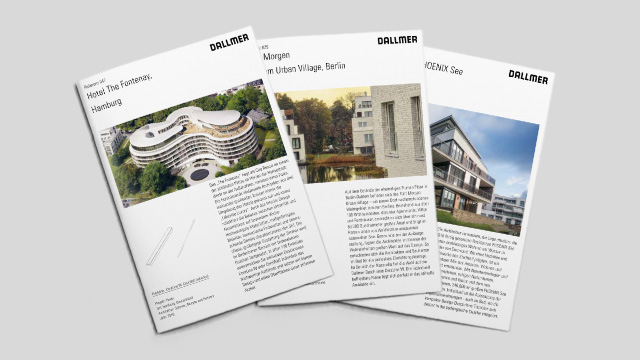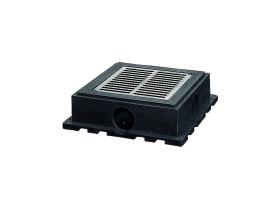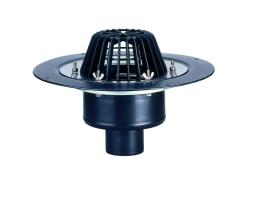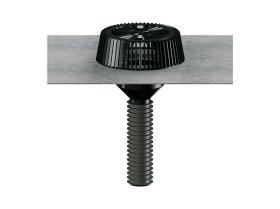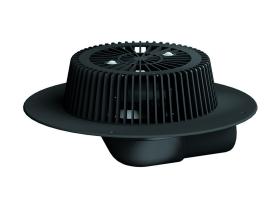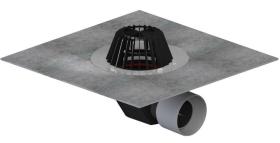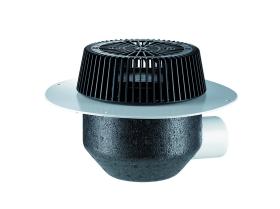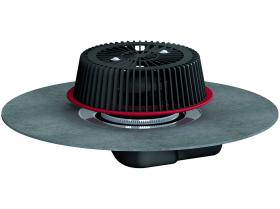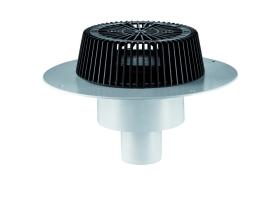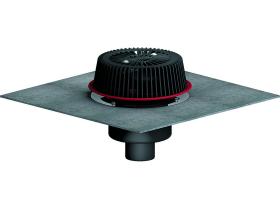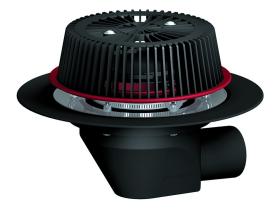Compact Knowledge – Roof drainage
At a glance
- The need for flat roof drainage
In order to prevent water accumulation and moisture damage, flat roofs need to be equipped with special drainage systems. - Type of flat roof drainage
Each drainage low point (roof sub-area) is allocated a roof drain and an overflow drain. - Overflow drains
Overflow drains are mandatory and ensure reliable drainage even in the event of extremely heavy rainfall.
- Active mechanisms
Methods of flat roof drainage: Gravity drainage
(gravity principle) and siphonic drainage (negative pressure). - Green roofs
Green roofs make a contribution towards climate control and, in cities, offer additional areas that enable the return of water to the natural water cycle. - DIN 1986-100:2016-12
The most important standard for the regulation of roof drainage in Germany.
Drainage of flat roofs
The drainage of flat roofs is essential to drain off rain water and to protect the roof against moisture damage and warping. Dallmer products are available for flat roofs of solid or lightweight construction and with a single or double-ply membrane. These days, the most common roof structure in Germany is the single-ply, non-ventilated flat roof (warm roof). This can also be converted to an inverted roof. Unlike a conventional non-ventilated flat roof, in an inverted roof construction the waterproofing is located beneath the thermal insulation. Different countries, different customs: in other countries, such as Switzerland, flat roof drains are often embedded in the concrete surface, while Germany primarily uses lightweight constructions. Technical details of the drainage solutions will always need to be tailored to the particular features of the building. Generally speaking, when dealing with flat roofs, a distinction is made between non-utilised surfaces, i.e. foot traffic only occurs for the purpose of maintenance, and utilised flat roofs, which can withstand the weight and impact of pedestrian and vehicle traffic.
Prerequisites for drainage systems and roof drains
In the case of flat roofs, drainage is carried out at roof low points; each low point of a roof surface is drained via a roof drain and an overflow drain. Drainpipes must be thermally insulated if the rooms below are heated as they represent thermal bridges in the roof structure. Heated drains prevent icing in freezing temperatures, particularly if the rooms below are not heated. All roof drainage must be cleaned and maintained twice a year (acc. to DIN 1986-3).
Roof drains must be positioned so that their flange outer edge is at least 30 cm away from the outer edges of other installations on the roof, joints or other ducts penetrating the roof membrane. Roof drains are delivered with connecting flanges that are either bonded or welded to the waterproofing membranes. This includes asphalt sheeting, PE, FPO-PP and PVC roof membranes. Polymer roof membranes can be secured using clamp rings. For connections to rising components, such as in the area of the parapet, but also windows and French windows, regulations stipulate a minimum height of 15 cm above the wearing layer or gravel filling for a roof pitch of up to 5°. If the roof pitch is greater, the minimum height is 10 cm (Flat Roof Directive, dated 2016, Section 4.3).
The requirements for roof drains are described in the standard DIN EN 1253. The requirements for the connection of roof drains are stipulated in the "Flat Roof Guidelines" of the German National Association of Roofers (ZVDH). Both gravity drainage and pressure pipe drainage systems may only be fitted with roof drains that have been tested and found suitable according to DIN EN 1253-2. Two-piece roof drains must have a sealed connection between the drain and the raising piece (DIN 1986-100:2016-12 § 5.7.3.1 General requirements).
Gravity and siphonic drainage
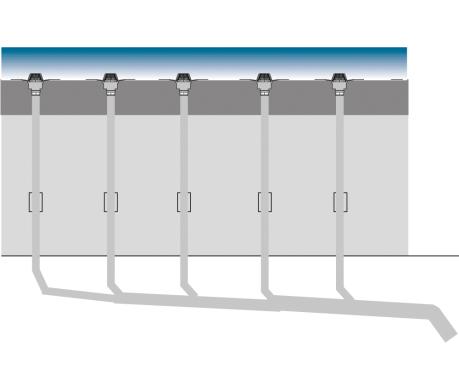
Conventional gravity drainage
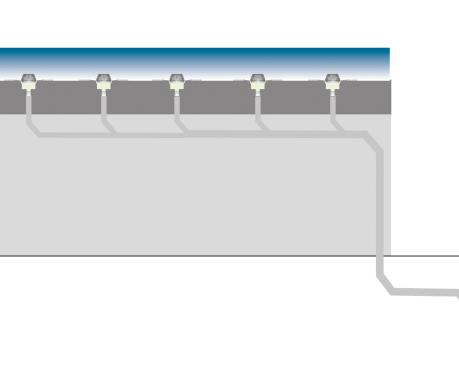
Siphonic roof drainage
Gravity drainage
With gravity drainage acc. to DIN EN 12056-3 § 6.1 (Gravity drainage) and DIN 1986-100:2016-12 § 14.2.7 the water is drained over several downpipes into a drainage pipe laid in the slope where it is drained away from the roof. Drainage of the rainwater occurs according to the physical law of gravity. The drainage rate is primarily influenced by the slope of the outlet pipe and the structure of the roof drain. The pipe system for gravity drainage should always be partially filled with water.
Siphonic drainage
In the case of siphonic drainage, the outlet flows of the individual drains are transported to a common downpipe via connecting pipes underneath the roof structure acc. to DIN 1986-100:2016-12 § 14.3. Drainage of the rainwater creates a negative pressure in the collecting main, which ensures the quick and effective drainage of the roof area at a high flow rate. Because the pressure pipe system is operated fully-filled acc. to the physical law of negative pressure, the pipes running underneath the roof can be laid without a slope, enabling spaces to be used more effectively. The high flow rate also creates a self-cleaning effect for the pipe system, which in turn reduces maintenance costs.
Overflow drainage
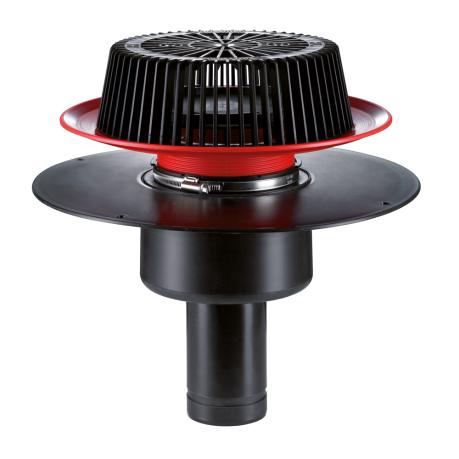
Dallmer overflow drain
According to DIN 1986-100:2016-12 § 5.9, the controlled functionality of the rain drainage system, both in the partial load range and in the event of an overload, e.g. in the case of once-in-a-century rainfall levels, must be ensured at all times. For such events, the standard stipulates the need for an overflow drainage system in the form of an overflow drain. Furthermore, the overflow drainage system must be connected to a dedicated outflow from which the water can drain freely onto floodable land - it must not be connected to the normal drainage system. For economic reasons, no public sewer system is designed to drain off extreme volumes of water, such as stormwater,so it is essential to ensure that the building is not at risk of flooding due to backwater in the sewer system. Builders may only dispense with overflow drainage if replacement measures are in place (e.g. in the case of ponding on the roof). Overflow drainage can also be carried out by additional overflow drains or parapet drains.
Green roofs
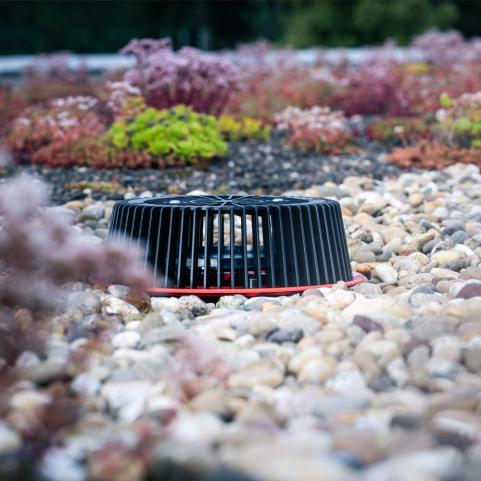
Dallmer green roof
Green roofs are a very special kind of flat roof, whereby a distinction
is made between "extensive greening" and "intensive greening". Extensive
greening is achieved with easy-care, low-growing groundcover, such as
herbs, moss, grasses and different kinds of sedum. Intensive greening
involves a greater variety of plants: perennials, shrubs, flowers,
sometimes even small trees. The only limiting factor is the stability of
the roof structure. Roofs with a load capacity of up to 150 kg/m2 can generally only support extensive greening, but a roof with a load capacity of approx. 500 kg/m2 enables intensive greening.
Green roofs make a key contribution towards handling the accumulating volumes of rainfall. Because our world is being increasingly paved over – this includes roads, built-up areas, even tunnels, which lead to the underground sealing of surfaces – there are fewer and fewer areas where the rainwater can naturally seep into the ground. This interrupts the natural water cycle, whereas green areas enable the natural evaporation and seepage of the water. Depending on the region and the vegetation, green roofs can absorb 30 - 90% of the rainfall. This also relieves the load on the public sewer system, which generally struggles to handle heavy rainfall. But green roofs offer many other advantage as they also ...
- serve as a substitute garden
- regulate the interior climate
- absorb fine dust particles, thus improving the air quality
- help mitigate the urban heat island effect
Drainage of balconies and patios
Green roofs are able to absorb a large part of the rainwater and then gradually deliver it to the drainage system. However, the situation is different when it comes to balconies, loggias and patios. The majority of the surface water accumulates immediately and undiminished, so the drainage happens at two levels: at surface level and at drainage level. The drainage of balconies and patios can be achieved using special drainage systems. Such systems may also be suitable for small roofs, such as garage roofs. They have the same design as roof drains, only smaller.
DIN 1986-100
The standard DIN 1986-100 is the most important standard for the regulation of roof drainage in Germany. It applies to wastewater drainage systems for buildings and sites. It regulates the planning and design of both gravity and siphonic drainage systems, whereby it also takes into account the calculations for roof drains, gutters and emergency overflow drainage and specifies the need for overflow certification. The standard was drawn up by the working committee of the NA 119-05-02 AA "Drainage systems for buildings and sites" of the DIN Standards Committee Water Practice (NAW).
Drainage systems must be installed for the drainage of rainwater. Only in exceptional cases and if no person suffers loss or damage, may the drainage happen by other means. Each low point in the roof structure must be fitted with an overflow drain. Drainage of flat roofs must not exceed the load capacity of the roof. Drains and outlet pipes must therefore be selected, designed and installed in such a manner as to permanently prevent ponding that could exceed the load capacity of the roof.
Roof drains must meet the requirements of the standard DIN EN 1253-2 and have a General Building Supervisory Authority Test Certificate. Drains must be freely accessible in order to allow problem-free maintenance. Manufacturers are obliged to publish the drainage rate of their products, depending on water over grate.
FLOW RATES ACCORDING TO DIN EN 1253 IN L/S FOR WATER OVER GRATE 5 – 75 MM
Shown here: Dallmer roof drain 62 clamp ring (vertical)
|
NOMINAL WIDTH |
DIN EN 1253 |
5 MM |
15 MM |
25 MM |
35 MM |
45 MM |
55 MM |
65 MM |
75 MM |
|
DN 70 |
1.7 ( 35 mm ) |
0.90 |
3.50 |
6.80 |
9.90 |
13.20 |
15.00 |
15.10 |
15.20 |
|
DN 100 |
4.5 ( 35 mm ) |
1.00 |
4.10 |
7.30 |
10.70 |
14.50 |
18.30 |
23.20 |
29.40 |
|
DN 125 |
7.0 ( 45 mm ) |
1.00 |
4.10 |
6.90 |
10.20 |
14.00 |
17.70 |
22.40 |
27.70 |
|
DN 150 |
8.1 ( 45 mm ) |
1.00 |
4.20 |
7.10 |
10.30 |
14.10 |
18.00 |
22.60 |
28.40 |
Number and position
How many drains a roof requires is determined by dividing the rainfall flow rate (l/s) of a (partial) roof surface by the selected drainage capacity of the selected roof drain (also l/s), taking into account the value for water over grate. Interior roof drains must be located in the low points of the roof structure. Furthermore, the outer edge of the flange must be at least 30 cm away from other installations on the roof and the roof membrane.
Waterproofing
The drain must be connected to the roof membrane in a way that ensures reliable sealing. The connection may be implemented using a loose-type, fixed or bonding flange or an integrated membrane.
The drainage system must be regarded and planned as a whole, whereby the following special features need to be taken into account for the various types of drainage:
- Overflow drainage
Overflow drains must not be connected to the normal drainage system, but to a dedicated outflow from which the water can drain freely onto floodable land. Each roof drain must be assigned an overflow drain with sufficient drainage capacity. - Gravity drainage
In accordance with DIN 1986-100 § 6.3.1, interior rainwater pipes must be able to withstand the pressure resulting from backflow if the drainage pipe is overloaded.
High-rise buildings > 22 m require special measures because a higher compressive strength must be taken into account. - Siphonic drainage
Because siphonic drainage systems are subject to pressure during operation, all components must be very precisely coordinated. Rainwater pipes designed for fully-filled operation may be laid without a slope.
The standard DIN 1986-100 stipulates the calculation basis used to calculate the expected volume of rainwater, i.e. the amount of rain to fall locally in five minutes (Kostra).
This is a coefficient for the calculation of rain volume – depending on region – that is to be expected statistically once every five years. This assumes a duration of five minutes rainfall and measures the volume in litres per second and hectare. Further key factors are the layout of the roof, the run-off coefficient and the specific dimensions and conditions of the respective drainage system.
Glossary
Part 3 of this standard is important for roof drainage as it stipulates the regulations for the planning and dimensioning of roof drains.
This standard applies to floor drains with and without trap inserts, and to roof drains. It stipulates the minimum requirements and test conditions under which the drainage capacity of the individual products is determined.
A component that sits in a drain to provide attachments for membranes. This may be a loose-type, fixed or bonding flange or an integrated membrane.
A guideline published by the German National Association of Roofers stipulates how flat roofs are to be waterproofed. Should be used in combination with the DIN standards.
The German KOSTRA Atlas allows for the quantifying of rain depth of an event for a certain recurrence interval and several duration intervals for each point in Germany.
The parapet is a low protective wall along the edge of a roof.
It is applied underneath the thermal insulation and prevents water vapour penetrating the thermal insulation.
The structure of a flat roof includes the substructure, the vapour barrier, the thermal insulation layer, the separating layer and the waterproofing membrane. However, no liability is assumed for the completeness of this list, as these layers can vary depending on roof type.
A term from the hydrology sector, which describes the ratio of rainfall that directly reaches the drain to total rainfall. The difference may be due, for example, to evaporation or seepage.
Belongs to the family of crassulaceae that are typically used to create living green roofs.
Also known as the base layer – supports the entire roof structure. Roof drains and overflow drains are anchored in this layer.
Lies on the load-bearing roof structure and protects the roof against the elements. In the case of flat roofs, this is the waterproofing layer.
Relevant products
Downloads
-
 Compact knowledge - Roof drainage - Print preview
PDF, 1554 KB
Compact knowledge - Roof drainage - Print preview
PDF, 1554 KB
Further downloads
Brochures, references, data sheets, etc. are available in our Download section.
Dated: October 2018










